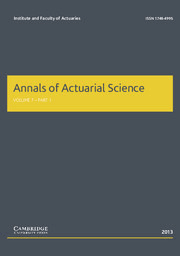
Annals of Actuarial Science
Scope & Guideline
Transforming theoretical knowledge into practical applications.
Introduction
Aims and Scopes
- Actuarial Modeling and Risk Assessment:
The journal focuses on the development and application of mathematical and statistical models to assess and manage risks associated with insurance, pensions, and financial products. - Data-Driven Approaches and Machine Learning:
There is a significant emphasis on utilizing machine learning techniques and data analytics to improve actuarial predictions, enhance model accuracy, and streamline insurance operations. - Health and Mortality Studies:
Research on health-related risks and mortality modeling is a core area, including studies on the impact of diseases, longevity risk, and the design of insurance products related to health. - Climate Change and Environmental Risks:
The journal includes discussions on the actuarial implications of climate change, such as risk modeling for natural disasters and the financial impacts of environmental policies. - Pension and Retirement Planning:
Papers often explore actuarial issues related to pension schemes, including risk management strategies and the modeling of various retirement outcomes. - Genetic and Behavioral Factors in Insurance:
An emerging focus on the intersection of genetics and behavioral science with traditional actuarial practices, particularly in life and health insurance.
Trending and Emerging
- Integration of Artificial Intelligence and Machine Learning:
Recent publications highlight the growing trend of incorporating AI and machine learning algorithms into actuarial science, particularly for risk assessment and predictive modeling. - Focus on Cyber Risk and Data Security:
As cyber threats escalate, there is an increasing emphasis on modeling and managing cyber risks within the insurance sector, including innovative approaches to risk quantification. - Pension De-risking Strategies:
The exploration of strategies for de-risking pension plans has gained traction, reflecting the need for effective management of longevity and investment risks. - Environmental and Climate Risk Assessment:
Emerging themes include the actuarial implications of climate change, with discussions on modeling natural disaster risks and the financial impacts of environmental policies. - Genetic and Behavioral Insights in Risk Assessment:
The integration of genetic testing and behavioral factors into actuarial science is on the rise, providing new insights for life and health insurance underwriting.
Declining or Waning
- Traditional Mortality Models:
There has been a noticeable decline in studies solely focused on traditional mortality models without incorporating advanced statistical techniques or machine learning, as newer approaches gain favor. - Basic Risk Assessment Techniques:
Simplistic risk assessment methods are becoming less common, with a shift towards more complex, data-driven methodologies that leverage big data and advanced analytics. - Static Insurance Pricing Models:
The journal has seen fewer contributions on static pricing models, as dynamic and adaptive pricing strategies become more relevant in the context of changing risk environments. - Homogeneous Risk Pooling Approaches:
Research that relies heavily on homogeneous pooling assumptions is declining, giving way to more nuanced models that account for heterogeneous risk factors. - Conventional Actuarial Theory without Practical Applications:
There is a waning interest in theoretical discussions that lack practical applications or empirical validation, as practitioners seek more actionable insights.
Similar Journals

Journal of Insurance Issues
Elevating Understanding in the Insurance SectorJournal of Insurance Issues, published by the Western Risk & Insurance Association, stands as a pivotal platform for the exploration and dissemination of knowledge in the field of insurance and risk management. With an ISSN of 1531-6076 and an E-ISSN of 2332-4244, this journal delves into the complexities and evolving dynamics of insurance practices, policies, and theoretical underpinnings. Although not an open-access journal, it remains accessible to a broad audience, including academics, practitioners, and students eager to engage with rigorous research and innovative ideas. The journal is dedicated to enhancing understanding in critical areas such as risk assessment, regulatory impacts, insurance economics, and consumer behavior, thereby contributing significantly to the professional discourse within the insurance sector. Its robust editorial standards ensure that published works meet high-quality scholarly criteria, further establishing the journal as an essential resource for anyone interested in the multifaceted world of insurance.

Risks is an esteemed Open Access journal published by MDPI, based in Switzerland, dedicated to exploring multifaceted dimensions of risk across various fields, including Accounting, Economics, Finance, and Management. Since its inception in 2013, the journal has fostered academic discourse by providing a platform for high-quality research that addresses contemporary challenges and theoretical advancements within these disciplines. With a commendable ranking in the 75th percentile for Economics, Econometrics and Finance, and distinction in Accounting and Strategy Management, Risks maintains robust academic quality that resonates within the global research community. The journal not only prioritizes accessibility with its Open Access model but also aims to bridge the gap between academia and industry through rigorous peer-reviewed publications. Researchers, professionals, and students alike will find Risks to be an invaluable resource for innovative insights and evidence-based analyses in the field of risk management.

Probability Uncertainty and Quantitative Risk
Navigating the Complexities of Uncertainty with PrecisionProbability Uncertainty and Quantitative Risk, published by the American Institute of Mathematical Sciences (AIMS), is a distinguished open-access journal that has been contributing to the academic community since its inception in 2016. With a focus on the crucial interplay between probability, uncertainty, and quantitative risk assessment, this journal serves as a vital platform for researchers, practitioners, and students engaged in the fields of Applied Mathematics and Statistics. The journal's ranking in the Q2 category for both Applied Mathematics and Statistics and Probability reflects its growing influence and relevance, while its diverse scope encourages interdisciplinary studies. As a part of the Scopus database and maintaining a consistent publication pace through 2024, Probability Uncertainty and Quantitative Risk is essential for anyone looking to remain at the forefront of research in risk analysis and uncertainty modeling. Its commitment to open access since 2016 further enhances accessibility to cutting-edge findings, making it an indispensable resource for academics and industry professionals alike.
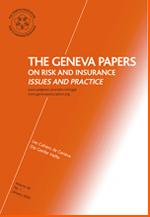
GENEVA PAPERS ON RISK AND INSURANCE-ISSUES AND PRACTICE
Transforming Insights into Actionable Insurance StrategiesGENEVA PAPERS ON RISK AND INSURANCE-ISSUES AND PRACTICE is a leading academic journal dedicated to advancing the fields of risk management and insurance, published by the esteemed Palgrave Macmillan Ltd. With an ISSN of 1018-5895 and an E-ISSN of 1468-0440, this journal serves as a pivotal platform for sharing cutting-edge research and practical insights addressing a diverse range of issues within the insurance sector. Established in 1999, it spans a wide array of topics, including risk assessment, financial implications, and policy development, contributing to its recognition in the Q2 quartile across multiple categories such as Accounting and Economics. With a notable Scopus ranking reflecting its relevance—ranked #229/716 in Economics and Econometrics, and #106/317 in Finance—it provides invaluable resources for scholars, professionals, and policymakers alike. Despite being a non-open-access journal, the GENEVA PAPERS ensures a rigorous peer-review process, aiming to uphold the highest standards of scholarly publication. Whether you are a researcher looking to publish groundbreaking studies or a practitioner seeking the latest trends and analyses in the insurance landscape, this journal stands out as an essential resource in the domain.
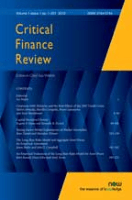
Critical Finance Review
Transforming finance through critical analysis and innovative thought.Critical Finance Review is a premier academic journal dedicated to advancing the field of finance through the publication of high-quality research that spans various dimensions of the discipline. Published by NOW PUBLISHERS INC, this journal has quickly established itself as a leading source of innovative finance scholarship, achieving a notable Q1 classification in the 2023 finance category. Operating under a rigorous peer-review process, the journal ensures the academic integrity and relevance of its content, which attracts contributions from both emerging and established scholars. With an ISSN of 2164-5744 and E-ISSN 2164-5760, it is accessible to a global audience, though it operates under traditional access models. The journal welcomes a diverse range of topics including, but not limited to, risk management, financial markets, and quantitative finance, making it an essential resource for researchers, professionals, and students who are keen to explore the complexities of financial systems and develop new insights in the ever-evolving landscape of finance. Based in the United States, Critical Finance Review holds a significant position within the academic community, fostering a collaborative environment that encourages innovative thinking and practical applications of financial theories.
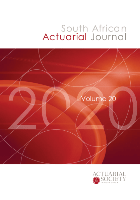
South African Actuarial Journal
Elevating the standards of actuarial practice and education.Welcome to the South African Actuarial Journal, a premier publication dedicated to advancing the field of actuarial science within the South African context and beyond. Published by the Actuarial Society of South Africa (ASSA), this journal serves as a vital platform for researchers, practitioners, and students to disseminate their findings, share innovative methodologies, and discuss contemporary challenges in actuarial practice. With an ISSN of 1680-2179, the journal encompasses a wide range of topics including risk management, insurance, pensions, and financial mathematics, making it an essential resource for those engaged in quantitative risk analysis. Although currently lacking an open access model, the journal's rigorous peer-review process ensures that all published articles maintain a high standard of quality and relevance. Engaging with the South African Actuarial Journal allows readers to stay at the forefront of developments in actuarial science, contributing to the profession's evolution and effectiveness in addressing the complexities of modern risk environments.

STOCHASTIC ENVIRONMENTAL RESEARCH AND RISK ASSESSMENT
Bridging Risk Assessment and Environmental InnovationSTOCHASTIC ENVIRONMENTAL RESEARCH AND RISK ASSESSMENT, published by Springer, stands as a pivotal resource in the field of environmental science, bridging the essence of probabilistic analysis with pressing environmental challenges. With an impact factor that underscores its Q1 rankings in multiple key categories—including Environmental Engineering and Safety, Risk, Reliability, and Quality—the journal fosters a vibrant arena for researchers, professionals, and students to explore innovative methodologies and applications. This scholarly platform, with a convergence of articles from 1999 to 2024, emphasizes the critical assessment of risks and uncertainties in environmental contexts. Notably, it offers Open Access options, ensuring a wider dissemination of groundbreaking research that paves the way for sustainable practices. Situated in the dynamic landscape of environmental chemistry and water science, the journal not only reflects current trends but also sets the stage for future advancements in risk assessment and environmental strategies.

Decisions in Economics and Finance
Exploring Innovative Solutions in EconomicsDecisions in Economics and Finance, published by SPRINGER INT PUBL AG, is a leading journal in the fields of economics, econometrics, and finance, providing a critical platform for researchers, professionals, and students to disseminate their findings and insights. With an impressive impact factor positioned in the Q2 category for both Economics and Finance in 2023, this journal is recognized for its rigorous peer-reviewed process and impactful research contributions. The journal spans over areas of general economics and finance, emphasized by its Scopus rankings, which place it in the 68th and 50th percentiles respectively. Since its inception in 1997 and continuing through its conferred years, Decisions in Economics and Finance continues to foster innovative approaches to economic and financial decision-making while bridging theoretical and practical applications. While it currently does not offer Open Access options, its commitment to quality research and interdisciplinary collaboration makes it a vital resource for anyone engaged in these dynamic fields.
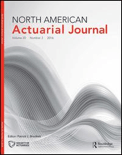
North American Actuarial Journal
Pioneering Knowledge in Statistics and UncertaintyNorth American Actuarial Journal is a prominent publication in the fields of Economics and Econometrics, Statistics and Probability, and Statistics, Probability and Uncertainty, published by Routledge Journals, Taylor & Francis Ltd. The journal, with the ISSN 1092-0277 and E-ISSN 2325-0453, covers critical advancements in actuarial science over the years from 1997 to 2024. With a strong Q2 ranking in multiple categories for 2023, the journal positions itself as a vital resource for researchers and practitioners looking to stay abreast of current trends and methodologies in actuarial practices. The journal’s focus on providing a platform for high-quality research makes it indispensable for professionals and academics alike, offering insightful contributions that influence the actuarial field's evolution. While it currently does not offer open access options, its rigorous peer-review process ensures the integrity and relevance of its published works. Researchers, professionals, and students in actuarial science will find this journal to be a valuable asset for both their studies and professional development.

Journal of Flood Risk Management
Exploring solutions to mitigate global flood challenges.The Journal of Flood Risk Management, published by WILEY, is a premier academic journal dedicated to advancing the understanding and management of flood risks, emphasizing interdisciplinary approaches in environmental engineering, geography, safety, and water science. Since its inception in 2009 and transitioning to an Open Access model in 2020, this journal has quickly established itself within the top quartile (Q1) across multiple categories, including Environmental Engineering and Geography, Planning and Development, reflecting its high impact and relevance in the field. With an impressive ranking among the top journals—62nd in Geography, 28th in Water Science and Technology, and 25th in Safety, Risk, Reliability and Quality—this journal serves as an essential platform for researchers, professionals, and students alike, providing them with valuable insights and innovations related to flood risk management. Situated in Denmark, the journal aims to foster collaboration and knowledge exchange, addressing critical challenges faced by societies globally in mitigating and adapting to flood risks.